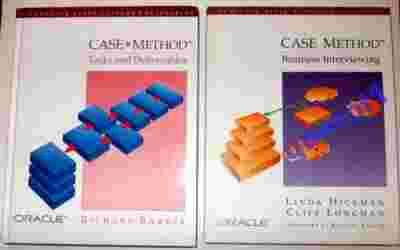Przedmiotem aukcji są dwie książki w języku angielskim:
CASE METHOD
Tasks and Deliverables
i
Business Interviewing
Bestsellery w dziedzinie biznesu i programowania w USA. Książki niedostępne w Polsce.
CASE METHOD
TASKS AND DELIVERABLES
ORACLE
Richard Baker
About Case Method: Tasks and Deliverables Analysts, project leaders and system developers can now build integrated business systems by using this complete guide to ORACLE's CASE Method. This highly practical book identifies the key tasks and defines the major deliverables required at every stage of the development life cycle. Highlights of the book include: clear checklists, estimating factors and quality controls for application system development helpful guidelines for reviewing user specifications, and choosing how and when to use prototyping comprehensive documentation forms for strategic planning through implementation. It is designed to be equally valuable as a training aid and as a 'hot- line' reference to ensure high-quality deliverables that meet the requirements of users.
Rok wydania: 1996
CASE METHOD
BUSINESS INTERVIEWING
ORACLE
Linda Hickman
Cliff Longman
Foreword by Richard Barker
This text emphasizes the key role of user feedback andinvolvement in formulating a business model andevolving a system architecture. The text also providesreaders with a variety of approaches to systemdevelopment. It gives practical advice on the conductof interviews at a variety of stages, along witheffective presentation techniques. This highlypractical book covers the basic techniques ofinterviewing clients and describes and illustratesdifferent approaches to the various stages of theirsystem development cycle.
" In our consultancy role, we find that interviews play a major part in the information gathering for any project. We have learned that the activity is a valuable opportunity for discovering many layers of information. Where we once looked on it as a data collection activity, now we consider it one that can provide real knowledge and understanding of the individuals we are interviewing.
We enjoy interviewing and have become more and more fascinated with the whole process of communication. We find ourselves interviewing in varied industries, countries and cultures. In such situations, we are looking at how we can best create an environment for a free interchange of ideas and be able to interpret accurately the information we gather. The last part is the most difficult. Semantics and differing sets of assumptions blur our view of what we have heard. Throughout any interview, we are trying to put aside our own preconceptions and listen with an open mind. It is not easy. The task is made easier, however, by having a set of techniques in hand for interviewing.
The mechanics of an interview are just that, mechanisms for smoothing a process. Once the interview process can be carried out with less effort, we can devote our time and attention to the real issues that are being discussed. That is why we are focusing in this book on the techniques for interviewing-on how to interview-with the goal of helping you have more time to concentrate on the real part of the interview-on what is actually being said.
Over the years we have come to value the practical techniques we have discovered which enable us to get below the surface in an interview to really understand the perspective of the interviewee. We believe that Information Technology practitioners in particular have an opportunity to improve their knowledge and understanding of what the needs of their business are and thus to dramatically improve the role they play in their business. Good interviewing techniques become an important asset.
The understanding we gain from an interview brings with it another challenge. We must often take information from one interview and combine it with results from several other interviews in order to build a picture or models, about our understanding. At this point, clarifying meaning becomes especially critical. It is the dilemma of converging various points of view that brings us closest to the real issue in an interview-understanding what is being said. We have been developing techniques to help us with that task and want to share them with others.
A book develops slowly. Several years ago Linda wrote some practical guidelines for interviewing. We used feedback from practitioners to expand the guidelines, which in turn formed the starting point for this book. We hope that this book will help to answer more questions and lead to rewarding and successful interviews.
To all - new and experienced alike - good luck.
AcknowledgmentsThe book evolved slowly and with the invaluable assistance of many people. We would like to thank a few personally, and hope that all the other special people who have influenced our ideas and development of the book will know who they are, too. In particular, Jeanette Longman spent many long hours patiently setting up material and resetting it; Barbara Barker has the genius to take all the parts and put them together in a readable, attractive book; as the originator of CASE Method, has a special role which cannot be measured.
Others also contributed along the way. Sue Ladbrook daily helps keep Linda's schedule manageable in countless ways, and among associates who read carefully and encouraged more interview materials were RenEe Taylor and Jeremy Davis. Countless colleagues in projects in may countries over the years have contributed to our understanding of interviewing.
Finally, a big thank you to our understanding families who have enthusiastically supported the idea of the book.
Linda Hickman and Cliff Longman
November 1994"
Rok wydania: 1994
Obie książki są wydane z tej samej serii, w twardych okładkach.
Wydawnictwo: ORACLE
Okładka: TWARDA
Stan książki: BDB++, jak widać na zdjęciu, Książki praktycznie jak nowe, wewnątrz stan idealny

